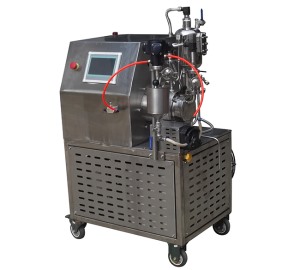
0.3LAll Ceramic Nano Laboratory Sander
Product Introduction
The ordinary Sander is a grinding machine with wide adaptability to raw materials and high efficiency at the present stage. The grinding chamber is relatively narrow, the clearance between the paddles is small, and the grinding kinetic energy is dense. It cooperates with the cooling system and the automatic control system to complete the continuous production, processing and feeding of raw materials and improve the productivity.
Sander, also known as ball mill, is mainly used for wet grinding of liquid products in chemical plants. According to performance indicators, it can be roughly divided into horizontal Sander, basket Sander, vertical Sander, etc. The key is composed of the human body, grinding cylinder, grinding disc (lever), grinding material, electric motor, and feeding pump, and the feeding speed is controlled by the feeding pump. The abrasives of the machine and equipment are generally divided into zirconia beads, glass beads, Zirconium(IV) silicate beads, etc.
Compared with ball mill, roller mill, micro powder machine and other grinding machines and equipment, Sander has the advantages of high production efficiency, low cost and high commodity fineness. There are significant differences in processing technology standards, and the fineness regulations can be adjusted and classified by adding or subtracting grinding materials appropriately.
Generally, there are vertical Sander, lithium Sander, horizontal Sander, basket Sander, double cone bar Sander, horizontal Sander. Except that the vertical Sander uses ordinary 2-3/3-4mm glass beads, other machine equipment uses 0.8-2.4mm zirconia beads.
The Sander adopts an eccentric disc grinding structure and is arranged in order. This system overcomes the disadvantage of uneven distribution of the grinding media of the traditional grinder, so that the grinding media can obtain greater energy transmission, and the grinding efficiency is high. It adopts a mechanical seal with double end faces and forced cooling, which is well sealed and operates. The separation system uses a large flow LDC dynamic grid slot separator, which will not block the outlet under the condition of large flow, and the flow area is up to, The gap range is 0.05-2.0mm, and grinding media above 0.1mm can be used.
The Sander adopts the disc type or rod pin type, closed cavity design, and the grinding plate is installed on the mixing shaft in order to overcome the shortcomings of the traditional horizontal Sander, such as uneven distribution of grinding media and poor particle size distribution after grinding. Materials enter the grinding chamber under the action of the feed pump. The inlet is designed to drive the end of the connecting flange. The flow direction of materials and the mechanical bearing are opposite to the bottom end. The mechanical seal of the silicon carbide Sander bears the pressure, Its service life is long. During the high-speed operation of the eccentric disc of the mixing shaft, the mixture of materials and grinding media undergoes relative motion. As a result, the solid particles of the material are dispersed, sheared, and ground. After passing through the dynamic large flow rotor gap separation filter, the product is obtained. Depending on the grinding process of the product, batch grinding or series grinding processes can be used.
